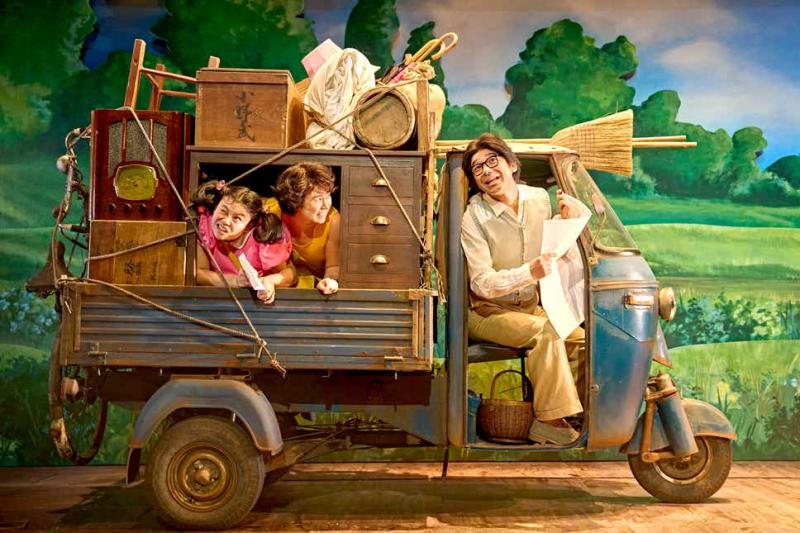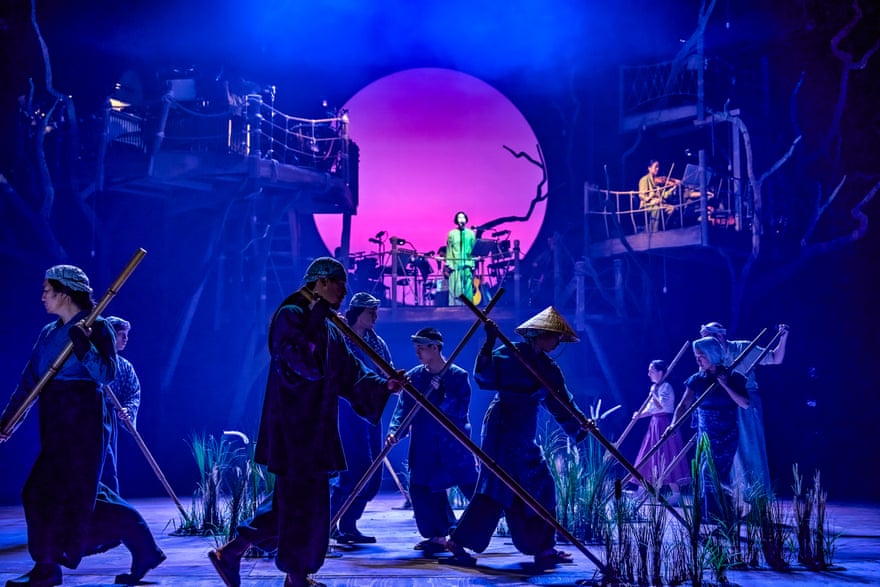My Neighbour Totoro, Barbican review - dazzling stage adaptation of a Japanese classic | reviews, news & interviews
My Neighbour Totoro, Barbican review - dazzling stage adaptation of a Japanese classic
My Neighbour Totoro, Barbican review - dazzling stage adaptation of a Japanese classic
Ingenious puppetry and music brings a classic 2-D animation to life on stage

As 10-year-old Satsuki observes as she arrives in the countryside with her little sister Mei, “We’re not in Tokyo anymore” – and they’re not in Kansas either, but there is a tang of Oz in the air. The 1988 Studio Ghibli film, My Neighbour Totoro has the classic status of The Wizard of Oz for a generation of youngsters brought up on whimsical Japanese animé.
From the opening scene, an ingenious riff on the movie’s title sequence that through a series of witty reveals transports the audience from a flat screen to the three-dimensional world of the stage, we know that we are in safe hands. We meet Satsuki, Mei and their father barrelling along in a tiny truck piled high with their belongings. The girls’ mother is ill in a rural convalescent hospital and the family has moved from the city to the country to be nearby. The girls delight in their new home – an old wooden house with a pump for water and the fresh air. Even the initially alarming soot sprites, black balls of feathery fluff, rapidly cease to alarm. The neighbours – local rice farmers and a kindly granny – are friendly and there are the woods to explore.
While Satsuki is at school, four-year-old Mei encounters the forest spirits, initially two small Totoros cheekily checking out the house’s new arrivals. Little furry creatures barrel around the stage, operated by graceful puppeteers in black pyjamas and veils, they are a cute foretaste of the wonder to come. Full scale Totoro is an enormous, furry blimp when we first meet him, asleep in the forest. He’s an ancient creature who can shake the earth with his toothsome roar, but from the moment Mei climbs on to his tummy, he's clearly a benign spirit. Over the course of the evening, we are treated to beautifully choreographed puppeteers manipulating ingenious creations designed by the Jim Henson company, whose late founder gave us the Muppets. It’s not just the giant Totoro, there’s a beautifully rendered Catbus – a 12-legged creature that can fly through the air like a giant glowing lantern, its eyes gleaming as it carries the children across the countryside to see their mother.
 It would be too much for actual child actors to take on these physically demanding roles, but it doesn’t take long to be convinced by Mei Mac that she’s an impulsive four-year-old who both delights and exasperates her thoughtful big sister, played by Ami Okumura Jones. Dai Tabuchi is a delight as the absent minded professor father while Nino Furumata gives an exact impression of the awkward local boy, Kanta from the original film.
It would be too much for actual child actors to take on these physically demanding roles, but it doesn’t take long to be convinced by Mei Mac that she’s an impulsive four-year-old who both delights and exasperates her thoughtful big sister, played by Ami Okumura Jones. Dai Tabuchi is a delight as the absent minded professor father while Nino Furumata gives an exact impression of the awkward local boy, Kanta from the original film.
Faithful to the movie’s original and slight narrative, there’s only a little jeopardy in the second half. Overall, this is a warm bath of a production guaranteed to delight families and adults with its ingenious, continuously revolving and evolving staging. The lighting and lovingly crafted sets are a delight in themselves. There are words of wisdom about being kind and respecting nature – a brief homily about how human exploitation of the countryside led to the forest spirits hiding away from them. Among the props moved around the stage to convey shifting landscapes are a series of Shinto figures – roadside statues and shrines with deities. If audiences are interested in their spiritual significance, it's best to turn to novelist Peter Carey’s 2004 book, Wrong About Japan where he offers an insightful analysis of the movie's subtler religious references.
Director Phelim McDermott has collaborated with the film’s original composer Joe Hisaishi to extend the role of music in the stage adaptation. It now plays a stronger role than just a jaunty theme and a bit of atmospheric soundtracking. Musicians play live perched high on tree-house platforms in full view, while Ai Ninomiya (above centre) dazzles on stage, singing in both Japanese and English. If the second half lags just a little (there's one chase scene too many), My Neighbour Totoro is still a dazzling show and will doubtless be a hit for the RSC and the Barbican.
The future of Arts Journalism
You can stop theartsdesk.com closing!
We urgently need financing to survive. Our fundraising drive has thus far raised £49,000 but we need to reach £100,000 or we will be forced to close. Please contribute here: https://gofund.me/c3f6033d
And if you can forward this information to anyone who might assist, we’d be grateful.

Subscribe to theartsdesk.com
Thank you for continuing to read our work on theartsdesk.com. For unlimited access to every article in its entirety, including our archive of more than 15,000 pieces, we're asking for £5 per month or £40 per year. We feel it's a very good deal, and hope you do too.
To take a subscription now simply click here.
And if you're looking for that extra gift for a friend or family member, why not treat them to a theartsdesk.com gift subscription?
more Theatre
 Interview, Riverside Studios review - old media vs new in sparky scrap between generations
Robert Sean Leonard and Paten Hughes make worthy sparring partners
Interview, Riverside Studios review - old media vs new in sparky scrap between generations
Robert Sean Leonard and Paten Hughes make worthy sparring partners
 Fat Ham, RSC, Stratford review - it's Hamlet Jim, but not as we know it
An entertaining, positive and contemporary blast!
Fat Ham, RSC, Stratford review - it's Hamlet Jim, but not as we know it
An entertaining, positive and contemporary blast!
 Juniper Blood, Donmar Warehouse review - where ideas and ideals rule the roost
Mike Bartlett’s new state-of-the-agricultural-nation play is beautifully performed
Juniper Blood, Donmar Warehouse review - where ideas and ideals rule the roost
Mike Bartlett’s new state-of-the-agricultural-nation play is beautifully performed
 The Gathered Leaves, Park Theatre review - dated script lifted by nuanced characterisation
The actors skilfully evoke the claustrophobia of family members trying to fake togetherness
The Gathered Leaves, Park Theatre review - dated script lifted by nuanced characterisation
The actors skilfully evoke the claustrophobia of family members trying to fake togetherness
 As You Like It: A Radical Retelling, Edinburgh International Festival 2025 review - breathtakingly audacious, deeply shocking
A cunning ruse leaves audiences facing their own privilege and complicity in Cliff Cardinal's bold theatrical creation
As You Like It: A Radical Retelling, Edinburgh International Festival 2025 review - breathtakingly audacious, deeply shocking
A cunning ruse leaves audiences facing their own privilege and complicity in Cliff Cardinal's bold theatrical creation
 Edinburgh Fringe 2025 reviews: Refuse / Terry's / Sugar
A Ukrainian bin man, an unseen used car dealer and every daddy's dream twink in three contrasting Fringe shows
Edinburgh Fringe 2025 reviews: Refuse / Terry's / Sugar
A Ukrainian bin man, an unseen used car dealer and every daddy's dream twink in three contrasting Fringe shows
 Faustus in Africa!, Edinburgh International Festival 2025 review - deeply flawed
Bringing the Faust legend to comment on colonialism produces bewildering results
Faustus in Africa!, Edinburgh International Festival 2025 review - deeply flawed
Bringing the Faust legend to comment on colonialism produces bewildering results
 Edinburgh Fringe 2025 reviews: Imprints / Courier
A slippery show about memory and a rug-pulling Deliveroo comedy in the latest from the Edinburgh Fringe
Edinburgh Fringe 2025 reviews: Imprints / Courier
A slippery show about memory and a rug-pulling Deliveroo comedy in the latest from the Edinburgh Fringe
 Edinburgh Fringe 2025 reviews: The Ode Islands / Delusions and Grandeur / Shame Show
Experimental digital performance art, classical insights and gay shame in three strong Fringe shows
Edinburgh Fringe 2025 reviews: The Ode Islands / Delusions and Grandeur / Shame Show
Experimental digital performance art, classical insights and gay shame in three strong Fringe shows
 Edinburgh Fringe 2025 reviews: Ordinary Decent Criminal / Insiders
Two dramas on prison life offer contrasting perspectives but a similar sense of compassion
Edinburgh Fringe 2025 reviews: Ordinary Decent Criminal / Insiders
Two dramas on prison life offer contrasting perspectives but a similar sense of compassion
 Edinburgh Fringe 2025 reviews: Kinder / Shunga Alert / Clean Your Plate!
From drag to Japanese erotica via a French cookery show, three of the Fringe's more unusual offerings
Edinburgh Fringe 2025 reviews: Kinder / Shunga Alert / Clean Your Plate!
From drag to Japanese erotica via a French cookery show, three of the Fringe's more unusual offerings
 The Two Gentlemen of Verona, RSC, Stratford review - not quite the intended gateway drug to Shakespeare
Shakespeare trying out lots of ideas that were to bear fruit in the future
The Two Gentlemen of Verona, RSC, Stratford review - not quite the intended gateway drug to Shakespeare
Shakespeare trying out lots of ideas that were to bear fruit in the future

Add comment